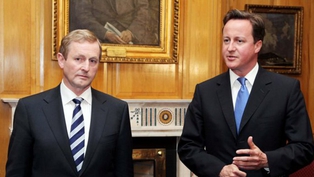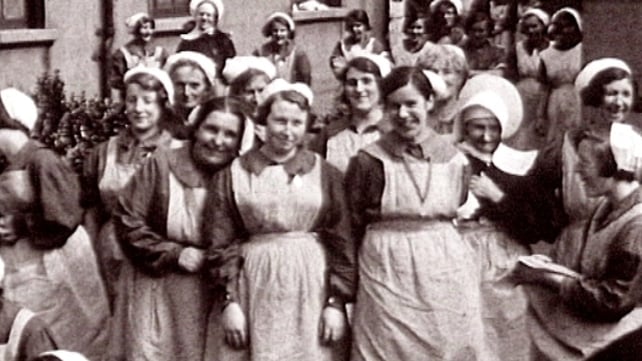Irish and British governments to trial common tourist visa this year
MOVE PART OF PLAN TO DRAW MORE HIGH-SPENDING VISITORS TO BOTH COUNTRIES
The Irish and British governments plan to pilot a single visa for travel to the two countries this year in a bid to boost tourism to both countries.
According to a report on how the Republic and UK can benefit from greater economic co-operation, the two governments are develping a common travel area visa to facilitate travel to and between both countries.
The report states that the work is now at an advanced stage. The British ambassador, Dominick Chilcott, said yesterday the two governments expect to begin piloting the common travel visa later this year.
Before such a visa could become a reality, the two jurisdictions need to agree on common application centres and on issues such as collecting electronic fingerprints and security data.
In 2011, the Republic waived visa requirements for tourists from 17 non-EU countries, including China, once they had a UK visa. A 21 per cent increase in visitors from those states over the first year of the waiver programme prompted the Government to extend it to 2016.
Greater collaboration on tourism is one of the areas highlighted in the report, which the two governments commissioned from PA Consulting and Cambridge Econometrics.
More attractive
The document indicates that both countries need to work on making themselves more attractive to travellers from long-haul destinations, specifically, China, whose tourists are known to be high-spending.
The global tourist industry is set to grow by 50 per cent between now and 2030, with half of that coming from China alone.
However, the report indicates that both are falling behind in the race to attract business from there. It suggests that France attracts one quarter more Chinese tourists than Britain.
“Resources could be pooled to understand why both countries’ products are not as appealing as they could be,” the report says.
It adds that once they have arrived at a perfect fit, both could work with tour operators to identify opportunities. One area it suggests the two countries could exploit is English-language training, as there is demand for this in Asia.
The report is due to be published shortly and follows on from a joint statement on co-operation between the two countries issued in March 2012 by Taoiseach Enda Kenny and Prime Minister David Cameron.
The statement committed the governments to evaluating the economic ties between the two states and the opportunities for mutually beneficial co-operation. The researchers spoke to policy makers, experts and business people when compiling the report.
Along with tourism, key areas covered include agriculture and food, research and innovation, and energy.
Magdalene survivors urge Irish mass-goers to boycott church services this weekend
Survivors of the Magdalene laundries have called on mass-goers to boycott church and any collections this weekend.
Women detained in the Catholic church workhouses have criticised religious orders for refusing to contribute to a compensation scheme and urged the public to hit them in the pocket.
More than 260 women have applied for the scheme, announced by the Government last month.
The Madgalene survivor Marina Gambold appealed to the public to back their fight for justice.
“It is not a big ask to call on people living in Ireland to support us and what we have suggested is a simple but powerful way of sending a clear message to the religious orders to do the right thing,” she said.
“Why can’t they do the right thing?
“Why do they want to make us suffer like this?
“They made us suffer behind closed doors many years ago and now they are doing it in public that is shocking, disappointing and disgusting.”
Julie McClure, who was detained at Stanhope Street, Dublin, said she worked day and night for the institution.
“What happened to us was a gross violation of our personal and fundamental human rights,” she added.
“Nobody seems to care that all we are asking is to be supported. Why can’t the Government do that?”
Taoiseach Enda Kenny and Justice Minister Alan Shatter have urged the religious orders – The Good Shepherd Sisters, The Sisters of Our Lady of Charity, The Sisters of Mercy and The Sisters of Charity – to consider contributing to the fund, which is expected to cost the state between 34.5 million and 58 million euro.
Campaign group Magdalene Survivors Together said the women want the public to help them get the orders to take responsibility.
Steven O’ Riordan, spokesman, also called on the Government to lift the Statute of Limitations ban in women taking future legal action if they sign up to the scheme.
“After the shocking and pathetic response from the Government, the women are now seeking the assistance of all decent citizens of this country to stand behind them,” he said.
“We want people to make it clear to the church that people are not happy with how the women are being treated by the four religious orders who ran Magdalene laundries.
“We need the help and the support from the public because it is clear that the Irish Government is totally out of their depth.”
Bank pursues junior minister John Perry over €2.5m unpaid loans
Danske Bank are to apply to court on Monday for case seeking judgment
Fine Gael Minister of State for small business John Perryand his wife are being pursued by a bank for a judgment over unpaid loans of almost €2.5 million
Danske Bank will apply to Mr Justice Peter Kelly on Monday to have its case seeking judgment for some €2.47 million, including interest, against Mr Perry and his wife Marie fast-tracked in the Commercial Court.
The bank claims the couple, of Carrownany, Ballymote, Co Sligo, are indebted arising from a October 2011 facility for €2.42 million provided to restructure existing loans.
It claims the security for the facility included first legal mortgages over a retail premises, the Stone Park Restuarant and Perry’s Hardware, all located at Main Street, Ballymote, and over some 50 acres of agricultural lands at Ballymote.
It claimed the loan was to be repaid in full some 12 months after it was drawn down in November 2011, with the effect the final repayment date was November 19th 2012.
The couple made some repayments but, the bank claims,failed to keep up the level of interim repayments required under the terms of the loan facility. Last March, it demanded immediate payment of the total sum outstanding, with interest, of about €2.46 million.
Late last May, solicitors for the bank demanded repayment of the total sum due within seven days.
The bank also claims it wrote to the couple in March 2012 under the Code of Conduct for Business Lending asking if they were in financial difficulty and drawing their attention to the information and resources availabe to them. It also claims it engaged with them in efforts to resolve the situation.
5000 Irish people could lose their eyesight in next five years
Age-related macular degeneration, diabetic retinopathy, cataract, and glaucoma are the main causes of sight loss in Ireland, reports the Irish College of Ophthalmologists (ICO).
Fortunately over 75% of sight loss is preventable with early diagnosis and treatment.
The ICO states that there are 220,000 Irish people currently living with vision loss or blindness. It is estimated that 5,000 more people will have impaired vision and 5,000 more people will lose their sight in Ireland within the next five years. This number could be reduced if more people had regular eye tests as it increases the likelihood of problems being spotted and treated early.
“Blindness and vision loss has a major health, social and economic impact,” says the ICO. “The risk of vision loss increases with age and in 10 years time, over 1 million Irish citizens will be aged 65 or older.”
Lending his support at the ICO’s eye health campaign launch in Killarney, Kerry Football Captain, Eoin Brosnan said, “People don’t necessarily think about their eye health until they notice something is wrong. The message from the eye doctors is to have our eyes checked regularly, particularly if you are in a higher risk category or if you notice any change in your vision.”
The free ICO booklet ‘Your Sight, Our Vision’ campaign includes eye health information to educate the public about the importance of early diagnosis and treatment of eye conditions, in order to prevent avoidable sight loss.
The booklet is available from your GP or by emailing info@eyedoctors.ie
Giant impact may have caused Mars planet lose its atmosphere
PROFESSOR BERNARD WOOD OF OXFORD UNIVERSITY SAYS MARS’ PRIMITIVE ATMOSPHERE WAS LOST THROUGH A SUDDEN “CATASTROPHIC” EVENT SUCH AS A GIANT IMPACT, SIMILAR TO THE ONE WHICH HAPPENED TO EARTH AND FORMED THE MOON.
Data returned by the Curiosity rover suggests a “catastrophic” event destroyed the atmosphere of the red planet around four billion years ago.
The Curiosity rover is on two-year investigatory mission to explore one of the most interesting areas of Mars, hunting for evidence of microbes and collecting a host of data and images from the red planet
According to a study of rock samples collected from the surface of the Gusev crater by Nasa’s Spirit rover were found to contain five times as much nickel as Martian meteorites found on Earth.
This suggests that the surface rocks, which are at least 3.7 billion years old, formed in an oxygen-rich environment while the meteorites, aged between 180 million and 1.4 billion years, did not.
Professor Bernard Wood of the department of earth sciences at Oxford University said: “This means most of Mars’ atmosphere has been lost sometime in the past. It seems likely that in the past Mars had a relatively thick atmosphere and it had water in that atmosphere.”
He said the data suggests that this primitive atmosphere was lost through a sudden “catastrophic” event like a giant impact, similar to the one which happened to Earth and which formed the moon.
Dublin Bay habitat conservation area welcomed
Tom Cassidy, Raheny, Dublin, with a newborn harbour porpoise at Portmarnock, Dublin, last month.
Designation will protect harbour porpoises, says Irish Whale and Dolphin Group
Designating Dublin Bay as a special area of conservation (SAC) will protect Ireland’s highest density of harbour porpoises, the Irish Whale and Dolphin Group (IWDG) has told Minister for Heritage Jimmy Deenihan.
The group, which welcomed Mr Deenihan on board its research vessel, the former Charlie Haughey-owned Celtic Mist, in Dún Laoghaire on Tuesday, said it was in favour of the proposed SAC from Rockabill to Dalkey Island.
The 27,000-hectare sea area is one of six such marine designations earmarked by Mr Deenihan under the EU Habitats Directive.
The others are the Blackwater bank off Co Wexford; the west Connacht coast; Hempton’s turbot bank off the north Donegal coast; the Porcupine bank canyon; and the southeast Rockall bank.
Mr Deenihan was in Dún Laoghaire to mark publication of the IWDG’s new atlas of marine mammals in Irish offshore waters.
The atlas of 16 species of whales, dolphins, seals and other mammals from 2005 to 2011 was compiled from research collected by IWDG observers who spent over 1,000 days at sea and 5,000 hours of survey effort over a period of six years.
The IWDG says the maps are essential in monitoring the status of cetaceans (marine mammals) in Irish waters, which are a designated whale and dolphin sanctuary. The information will also help to inform environmental and strategic impact assessments, it says.
Two years ago, the IWDG was donated the Celtic Mist ketch by the Haughey family, and it has been restored as a research vessel. It is currently being used to conduct surveys and train IWDG members and volunteers in Irish waters.











No comments:
Post a Comment